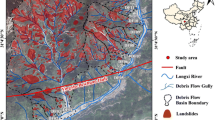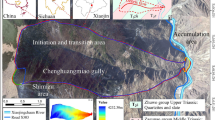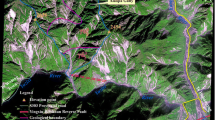Abstract
On August 20, 2019, many catastrophic debris flows broke out in meizoseismal area of Wenchuan M s 8.0 earthquake in China under the influence of continuous heavy rainfall. This paper takes the Chutou gully debris flow event occurred on August 20, 2019 as an example. The 3-D numerical simulation software, RAMMS, is used to back calculate the event and predict the future hazard. Coulomb and viscous turbulent friction, μ and ξ are calibrated in RAMMS. Numerical simulation reveals the movement process of Chutou gully from the aspects of flow depth, velocity, discharge, and run-out solid materials volume. The simulation results show that more than two-thirds of the solid materials are still deposited in the main channel, which could provide material basis for the re-occurrence of high hazard debris flow. In addition, based on the intensity and probability of debris flow, the hazard of debris flow is divided into high, middle, and low degrees. According to the simulation results and hazard assessment model, the hazard map of Chutou gully debris flow in various rainstorm return periods (20, 50, 100, and 200 years) is established, which can provide guidance for the future land-use planning and debris flow prevention works.
















Similar content being viewed by others
References
Bartelt, P., Bieler C., Bühler Y., Christen M., Deubelbeiss Y., Graf C., ... & Schneider, M. 2017. RAMMS: debris flow user manual. 15-16.
Bartelt P, Salm B, Gruber U (1999) Calculating dense-snow avalanche runout using a Voellmy-fluid model with active/passive longitudinal straining. J Glaciol 45(150):242–254
Bertolo P, & Bottino G (2008) Debris-flow event in the Frangerello stream-Susa valley (Italy)—calibration of numerical models for the back analysis of the 16 October, 2000 rainstorm. landslides, 5(1), 19-30.
Chang FJ, Chiang YM, Lee WS (2009) Investigating the impact of the Chi-Chi earthquake on the occurrence of debris flows using artificial neural networks. Hydrol Process 23:2728–2736
Christen M, Kowalski J, Bartelt P (2010) RAMMS: numerical simulation of dense snow avalanches in three-dimensional terrain. Cold Reg Sci Technol 63(1-2):1–14
Chang M, Tang C, Van Asch TW, Cai F (2017) Hazard assessment of debris flows in the Wenchuan earthquake-stricken area, South West China. Landslides 14(5):1783–1792
Chen X, Cui P, You Y, Chen J, Li D (2014) Engineering measures for debris flow hazard mitigation in the Wenchuan earthquake area. Eng Geol 194:73–85
Crosta G (1998) Regionalization of rainfall thresholds: an aid to landslide hazard evaluation. Environ Geol 35(2-3):131–145
Fan X, Scaringi G, Domènech G, Yang F, Guo X, Dai L et al (2019a) Two multi-temporal datasets that track the enhanced landsliding after the 2008 Wenchuan earthquake. Earth Syst Sci Data 11:35–55
Fan X, Scaringi G, Korup O, West AJ, Van Westen CJ, Tanyas H et al (2019b) Earthquake-induced chains of geologic hazards: patterns, mechanisms, and impacts. Rev Geophys 57:421–503
Fiebiger G (1997) Hazard mapping in Austria. Journal of Torrent, Avalanche, Landslide and Rockfall Engineering 61(134):121–133
Frank F, McArdell BW, Oggier N, Baer P, Christen M, Vieli A (2017) Debris-flow modeling at Meretschibach and Bondasca catchments, Switzerland: sensitivity testing of field-data-based entrainment model. Nat Hazards Earth Syst Sci 17(5):801–815
Gan J, Zhang YS (2019) Numerical simulation of debris flow runout using Ramms: a case study of Luzhuang Gully in China. Comput Model Eng Sci:981–1009
Ge YG, Cui P, Zhang JQ, Zeng C, Su FH (2015) Catastrophic debris flows on July 10th 2013 along the Min River in areas seriously-hit by the Wenchuan earthquake. J Mt Sci 12:186–206
Guo X, Cui P, Li Y, Fan J, Yan Y, Ge Y (2016) Temporal differentiation of rainfall thresholds for debris flows in Wenchuan earthquake-affected areas. Environ Earth Sci 75:109
He K, Li Y, Ma G, Hu X, Liu B, Ma Z, Xu Z (2020) Failure mode analysis of post-seismic rockfall in shattered mountains exemplified by detailed investigation and numerical modelling. Landslides. https://doi.org/10.1007/s10346-020-01532-1
He K, Ma G, Hu X, Liu B (2021) Failure mechanism and stability analysis of a reactivated landslide occurrence in Yanyuan City, China. Landslides. https://doi.org/10.1007/s10346-020-01571-8
Horton AJ, Hales TC, Ouyang C, Fan X (2019) Identifying post-earthquake debris flow hazard using Massflow. Eng Geol 258:105134
Huang RQ, Li WL (2009) Analysis on the number and density of landslides triggered by the 2008 Wenchuan earthquake, China. Journal of Geological Hazards and Environment Preservation 20:1–7 (In Chinese)
Huang X, Tang C, Zhou W (2014) Numerical simulation of occurrence frequency estimation model for debris flows. J Eng Geol 22(06):1271–1278 (In Chinese)
Hu W, Xu Q, Asch TV (2014) Experimental study on the initiation of debris flow. Research & Applications, Unsaturated Soils
Li TT, Huang RQ, Pei XJ (2016) Variability in rainfall threshold for debris flow after Wenchuan earthquake in Gaochuan River watershed, Southwest China. Natural Hazards 82 (3):1967-1980
Lin CW, Shieh CL, Yuan BD, Shieh YC, Liu SH, Lee SY (2004) Impact of Chi-Chi earthquake on the occurrence of landslides and debris flows: example from the Chenyulan River watershed, Nantou, Taiwan. Eng Geol 71:49–61
Lin JY, Yang MD, Lin BR, Lin PS (2011) Risk assessment of debris flows in Songhe Stream, Taiwan. Eng Geol 123(1-2):100–112
Luo G, Hu XW, Liang JX (2017) Stability evaluation and prediction of the Dongla reactivated ancient landslide as well as emergency mitigation for the Dongla Bridge. Landslides 14:1403–1418
Ma C, Wang Y, Hu K, Du C, Yang W (2017) Rainfall intensity–duration threshold and erosion competence of debris flows in four areas affected by the 2008 Wenchuan earthquake. Geomorphology 282:85–95
Medina V, Marcel H, Bateman A (2008) Application of FLAT-Model, a 2D finite volume code, to debris flows in the northeastern part of the Iberian Peninsula. landslides 5(1):127–142
Minatti L, Pasculli A (2011) SPH numerical approach in modelling 2D muddy debris flow. In: International Conference on Debris-Flow Hazards Mitigation: Mechanics, Prediction, and Assessment, Proceedings, pp 467–475
Naef D, Rickenmann D, Rutschmann P, McArdell BW (2006) Comparison of flow resistance relations for debris flows using a one-dimensional finite element simulation model. Nat Hazards Earth Syst Sci 6(1):155–165
Pastor M, Blanc T, Haddad B, Petrone S, Sanchez Morles M, Drempetic V et al (2014) Application of a SPH depth-integrated model to landslide run-out analysis. Landslides 11(5):793–812
Penserini BD, Roering JJ, Streig A (2017) A morphologic proxy for debris flow erosion with application to the earthquake deformation cycle, Cascadia Subduction Zone, USA. Geomorphology 282:150–161
Prochaska AB, Santi PM, Higgins JD, Cannon SH (2008) A study of methods to estimate debris flow velocity. Landslides 5:431–444
Pudasaini SP, & Hutter K (2007) Avalanche dynamics: dynamics of rapid flows of dense granular avalanches. Springer Science & Business Media.
Rickenmann D, Laigle D, Mcardell BW, Hübl J (2006) Comparison of 2D debris-flow simulation models with field events. Comput Geosci 10(2):241–264
Savage SB, Hutter K (1989) The motion of a finite mass of granular material down a rough incline. J Fluid Mech 199:177–215
Shen YM, Chen TL, Xiao GJ et al (1984) Flood calculation manual of small watershed in Sichuan province. China. 15-17 (In Chinese)
Stolz A, Huggel C (2008) Debris flows in the Swiss National Park: the influence of different flow models and varying DEM grid size on modeling results. Landslides 5(3):311–319
Tang C, Zhu J, Ding J et al (2011) Catastrophic debris flows triggered by a 14 August 2010 rainfall at the epicenter of the Wenchuan earthquake. Landslides 8 (4):485-497
Wang J, Yang S, Ou G, Gong Q, Yuan S (2018) Debris flow hazard assessment by combining numerical simulation and land utilization. Bull Eng Geol Environ 77(1):13–27
Wu H, Jiang Y, Zhang X (2015) Flow models of fluidized granular masses with different basal resistance terms. Geomechanics & Engineering 8(6):811–828
Yan Y, Cui YF, Yin SY (2020) Landslide reconstruction using seismic signal characteristics and numerical simulations: case study of the 2017 “6.24” Xinmo landslide [J]. Eng Geol 270:105582
Zhang N, Takashi M, Ningbo P (2018) Numerical investigation of post-seismic debris flows in the epicentral area of the Wenchuan earthquake. Bull Eng Geol Environ 78:3253–3268
Acknowledgments
Meanwhile, the authors would like to thank the two anonymous reviewers for their valuable comments, which significantly improved the manuscript.
Funding
The authors would like to acknowledge the National key research and development program (2018YFC1505401), National Natural Science Foundation of China (41731285, 41672283), Youth Fund Project of NSFC (41907225) and Open fund of State Key Laboratory of geological disaster prevention and geological environment protection (SKLGP2018K011) for their strong support for this topic.
Author information
Authors and Affiliations
Corresponding author
Ethics declarations
Competing interests
The authors declare that they have no competing interests.
Rights and permissions
About this article
Cite this article
Liu, B., Hu, X., Ma, G. et al. Back calculation and hazard prediction of a debris flow in Wenchuan meizoseismal area, China. Bull Eng Geol Environ 80, 3457–3474 (2021). https://doi.org/10.1007/s10064-021-02127-3
Received:
Accepted:
Published:
Issue Date:
DOI: https://doi.org/10.1007/s10064-021-02127-3




